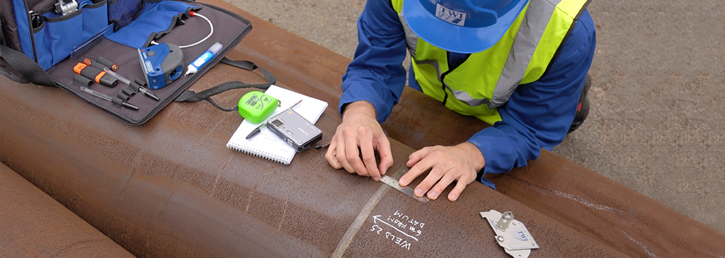How Welding Inspection Madison Ensures Top Quality and Safety in Fabrication
How Welding Inspection Madison Ensures Top Quality and Safety in Fabrication
Blog Article
The Significance of Thorough Welding Examination in Industrial Applications
In the realm of commercial applications, the value of precise welding examination can not be overstated. As we explore the diverse advantages of attentive welding inspections, one need to take into consideration the wider implications on safety, dependability, and cost-effectiveness in commercial procedures.
Enhancing Architectural Stability
When it comes to welding assessment in industrial applications, enhancing structural integrity is critical. The primary objective of welding assessment is to guarantee that the welds are capable of bearing the anticipated tons and stresses they will certainly come across in service.
The importance of keeping architectural stability in bonded frameworks can not be overemphasized. Improperly performed welds can lead to disastrous failings, causing expensive repairs, downtime, and also endangerment of human lives. Examiners play an important function in the lifecycle of commercial components, offering guarantee that the welding process delivers the desired stamina and resilience.
Furthermore, advanced innovations, such as phased variety ultrasonic testing and digital radiography, deal enhanced capabilities in discovering possible weaknesses, enabling for rehabilitative steps before problems rise. By prioritizing the stability of welds via thorough assessment, markets can ensure operational performance and expand the long life of their facilities.
Identifying Welding Issues
Identifying welding defects is a vital facet of making certain the safety and security and reliability of welded structures. Common welding defects consist of porosity, splits, insufficient blend, and damaging.

Skilled examiners utilize both visual exam and advanced non-destructive screening (NDT) methods, such as ultrasonic or radiographic screening, to detect these problems. The prompt identification and rectification of welding issues are imperative to preserve the architectural stability and long life of industrial elements.
Making Certain Conformity Standards
Compliance with well established standards, such as those given by the American Welding Culture (AWS) and the International Company for Standardization (ISO), makes sure that welds satisfy minimum safety and quality needs. These requirements include a wide array of criteria, including product specifications, welding treatments, and credentials of welders.
Normal audits and inspections are essential in verifying conformity. Assessors should possess a thorough understanding of the appropriate criteria and be skilled at using numerous non-destructive screening (NDT) methods to evaluate weld high quality. By making sure that welding practices straighten with compliance criteria, companies alleviate the threat of non-conformity, which can result in lawful liabilities and security threats.
Furthermore, keeping conformity not only safeguards structural honesty but additionally enhances a business's online reputation in the industry. Customers and stakeholders are most likely to count on firms that constantly show a dedication to quality and safety with strenuous conformity. Thus, guaranteeing compliance requirements is a critical element in the successful application of welding in commercial applications.
Lowering Upkeep Prices

The application of sophisticated non-destructive testing (NDT) techniques, including ultrasonic, radiographic, and magnetic fragment examinations, improves the ability to detect subsurface imperfections without jeopardizing the structural stability of components. By utilizing these techniques, markets can considerably extend the life span of their equipment, lowering downtime and the associated economic burden of upkeep tasks.
Moreover, a robust welding assessment regime supports the optimization of upkeep schedules, moving from responsive to predictive upkeep strategies. This positive strategy not only reduces unanticipated failures yet also enhances source allotment, making sure that upkeep efforts are focused and efficient. Eventually, the investment in strenuous welding assessment is offset by advice the considerable cost savings realized through reduced upkeep needs, adding favorably to the overall operational effectiveness of industrial business.
Improving Safety Procedures
Although safety and security is a critical worry in commercial procedures, achieving optimal safety requirements needs a specialized emphasis on the quality and integrity of bonded see here frameworks. Welding assessment plays a critical role in this context, as it ensures that all connections and joints meet stringent security criteria. Comprehensive evaluations help identify defects such as cracks, porosity, or incomplete fusion that can endanger architectural stability. Such flaws, if left unaddressed, position considerable risks, potentially leading to tragic failings.
Techniques like ultrasonic testing, radiographic testing, and magnetic bit inspection allow for in-depth examination without damaging the structure. Applying a robust high quality control system that includes regular training for assessors and welders guarantees adherence to established safety and security criteria.
Lastly, fostering a culture of security within the company emphasizes the importance of complete welding examinations. Encouraging open communication and collaboration amongst examiners, engineers, and welders adds to a common dedication to safety and security quality. Welding Inspection Madison. In doing so, markets can guard their procedures, shield employees, and keep public trust fund

Final Thought
Extensive welding assessment is vital in industrial applications, considerably enhancing architectural stability and dependability. By employing advanced non-destructive screening techniques, prospective welding defects such as splits and incomplete fusion are recognized early, making sure compliance with market standards and cultivating client trust. Strenuous assessments result in minimized maintenance prices and add to a safer working setting. Eventually, the diligent execution of welding evaluations plays an important role in preserving operational effectiveness and safety in industrial setups.
As we check out the diverse benefits of thorough welding inspections, one need to take into consideration the broader ramifications on safety and security, reliability, and cost-effectiveness in industrial procedures.
The main objective of welding evaluation is to make sure that the welds are qualified of birthing discover here the anticipated loads and tensions they will run into in service. Reliable welding inspection plays an essential function in lessening these prices by ensuring the integrity and longevity of welds, thus alleviating the threat of early failures.Detailed welding inspection is essential in industrial applications, considerably improving structural integrity and reliability. Eventually, the thorough implementation of welding assessments plays a vital duty in keeping functional efficiency and security in industrial settings.
Report this page